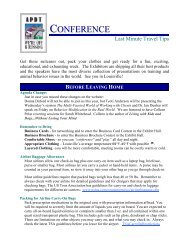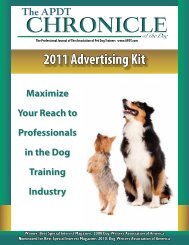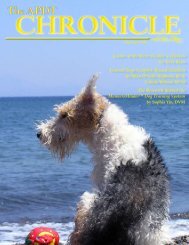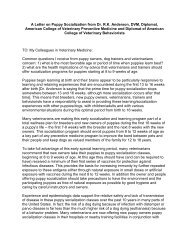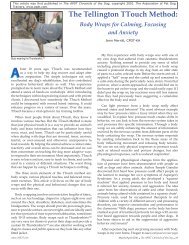of the Dog - Association of Pet Dog Trainers
of the Dog - Association of Pet Dog Trainers
of the Dog - Association of Pet Dog Trainers
You also want an ePaper? Increase the reach of your titles
YUMPU automatically turns print PDFs into web optimized ePapers that Google loves.
Teaching Classes<br />
Safety First<br />
Joan B. Guertin<br />
It Iis hard to believe that it was just a few months over 50<br />
years ago when I, a well-meaning but inexperienced pet<br />
owner, blundered into <strong>the</strong> chaos that was my first dog<br />
training class.<br />
Kadee, <strong>the</strong> first <strong>of</strong> our German Shepherds who would<br />
live with us over a period <strong>of</strong> 18 years, was, at 4 , extremely<br />
well behaved compared to <strong>the</strong> rest <strong>of</strong> <strong>the</strong> dogs at <strong>the</strong> city<br />
park in Phoenix, that first night. But, having been raised<br />
with dogs, and already being <strong>the</strong> mo<strong>the</strong>r <strong>of</strong> one active little<br />
girl and with a second child due imminently, I apparently<br />
was <strong>the</strong> only one on <strong>the</strong> field who understood that children<br />
and dogs should mind <strong>the</strong>ir manners, and that ultimately,<br />
I was <strong>the</strong> pack leader!<br />
Thirteen weeks later, with diploma in hand and<br />
an invitation to return to <strong>the</strong> Grand Canyon German<br />
Shepherd <strong>Dog</strong> Club as an apprentice trainer, little did I<br />
know that <strong>the</strong> die was cast for <strong>the</strong> rest <strong>of</strong> my life.<br />
While turning out well-behaved dogs was always <strong>the</strong><br />
primary goal <strong>of</strong> <strong>the</strong> many classes I taught over <strong>the</strong> years,. I<br />
discovered that <strong>the</strong> sentence wasn’t complete until I added<br />
“in a safe environment.” Today, when I monitor classes,<br />
<strong>the</strong> first thing I note is just how safe is that environment.<br />
By <strong>the</strong> mid-1980s I became aware that students were<br />
arriving at classes with more behavior issues and fewer<br />
skills to deal with <strong>the</strong>m and less experience with <strong>the</strong><br />
animals that <strong>the</strong>y had invited into <strong>the</strong>ir lives. I deduced<br />
that our more transient life styles which changed<br />
drastically following <strong>the</strong> Second World War, had led<br />
to more gravitation from <strong>the</strong> farm and/or small town<br />
living, to <strong>the</strong> big cities and our city dwellers <strong>of</strong>ten grew<br />
up in apartments and hadn’t been raised with dogs.<br />
Thus, inherent skills no longer existed. In addition <strong>the</strong>ir<br />
education in dog behavior was generally gained through<br />
watching Lassie and Rin Tin Tin on TV.<br />
This is when I began formulating my plan for<br />
conducting safe classes for students with little or no<br />
practical experience in dealing with an animal on four legs<br />
with teeth, and all too <strong>of</strong>ten convinced that Rover, Fifi or<br />
Bruiser were just children with a fur or hair coat.<br />
At first, my training team and apprentices, were skeptical<br />
<strong>of</strong> <strong>the</strong> need for safety drills. The majority <strong>of</strong> <strong>the</strong> classes were<br />
held in parks in sunny Nor<strong>the</strong>rn California. There was<br />
lots <strong>of</strong> space so we could keep dogs a safe distance apart.<br />
However, during any class period, invariably students<br />
would group closely so <strong>the</strong>y could chat! Then, <strong>the</strong>re were<br />
those who were convinced that Rover, attentive at home,<br />
would continue to respond as well in <strong>the</strong> open park, so<br />
<strong>the</strong>y would show up with <strong>the</strong> dog <strong>of</strong>f leash. Add to that<br />
those who would show up with unruly children vying<br />
for <strong>the</strong> parents’ undivided attention. It all was obviously<br />
a recipe for disaster. It was time to apply <strong>the</strong> same sort <strong>of</strong><br />
order in <strong>the</strong> open air class room that I would employ in a<br />
school class room. It seemed to be <strong>the</strong> best way to avoid<br />
fights and bites!<br />
And, unfortunately, working outdoors in open areas,<br />
<strong>the</strong>re was always a risk <strong>of</strong> loose dogs. We had to develop<br />
strategies to keep <strong>the</strong> classes safe regardless <strong>of</strong> <strong>the</strong> situation.<br />
As a result, we established <strong>the</strong> Saturday morning meeting<br />
ritual.<br />
Following <strong>the</strong> classes we would meet for 30 to 45<br />
minutes to review our day. It became <strong>the</strong> ideal time to<br />
develop and work on some strategies should <strong>the</strong>re become<br />
a “worse case scenario.” At first <strong>the</strong> team really thought<br />
I was being an alarmist! Later, <strong>the</strong>y understood my<br />
reasoning as <strong>the</strong> “worst case scenario” became reality!<br />
A woman brought her Bull Terrier to class so that we<br />
could do an evaluation. She was to arrive after <strong>the</strong> class<br />
with dog properly leashed. I even took <strong>the</strong> time to explain<br />
that both leash and collar should be on <strong>the</strong> dog prior to<br />
leaving home so that she would have a secure hold on <strong>the</strong><br />
dog. I also requested that she leave <strong>the</strong> dog in <strong>the</strong> car until<br />
<strong>the</strong> field was clear. However, <strong>the</strong> dog spotted <strong>the</strong> class upon<br />
arrival and when she opened her door, he pushed past her.<br />
He had no leash and no collar. And made a beeline for my<br />
class group with eyes glued to a small Dachshund!<br />
All I said was “loose dog” and immediately all three <strong>of</strong><br />
my trainers (each with <strong>the</strong>ir own group and an assistant),<br />
gave a group Stay which meant <strong>the</strong> assistant took charge<br />
<strong>of</strong> <strong>the</strong> class. The trainers converged on my class, with <strong>the</strong><br />
lone male focused on <strong>the</strong> freight-train <strong>of</strong> a Bull Terrier<br />
who was determined to have a “weenie dog” for lunch.<br />
My trainer closed in on <strong>the</strong> rear end <strong>of</strong> <strong>the</strong> terrier, grabbed<br />
his hind legs and lifted <strong>the</strong>m <strong>of</strong>f <strong>the</strong> ground. He held<br />
him suspended <strong>the</strong>re until <strong>the</strong> owner joined us and put<br />
collar and leash on <strong>the</strong> dog and returned him to <strong>the</strong> car.<br />
The entire incident took place in about five minutes. My<br />
team worked quietly, no hysterics, no yelling. The majority<br />
<strong>of</strong> <strong>the</strong> classes had no idea what had taken place. And <strong>the</strong><br />
team never again sc<strong>of</strong>fed at my request for “worst-casescenario”<br />
drills!<br />
I cannot stress enough, <strong>the</strong> importance <strong>of</strong> drills. You<br />
may never have to implement <strong>the</strong> action. However, you<br />
will not be taken by surprise if you drill in advance and<br />
have your basic strategy worked out. It allows <strong>the</strong> trainer<br />
and anyone else working with <strong>the</strong> class to remain calm!<br />
Most disasters are born out <strong>of</strong> <strong>the</strong> panic that can surround<br />
an incident. Preparedness allows those on site to deal with<br />
such incidents calmly and thus with little or no tragedies.<br />
Later when I moved to <strong>the</strong> Midwest and was training in<br />
smaller venues with dogs and handlers in closer proximity,<br />
it was necessary to institute some additional safety<br />
practices. I firmly believe that providing students a safe<br />
environment in which to learn is every bit as important<br />
as getting <strong>the</strong>m into class in <strong>the</strong> first place. Following are<br />
ideas that we employed to keep both [continued on next page]<br />
www.APDT.com 23 w The APDT Chronicle <strong>of</strong> <strong>the</strong> <strong>Dog</strong> w November/December 2008



